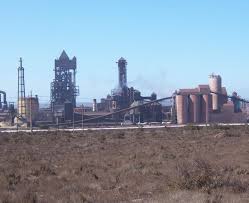In the present article we
give a brief data about how the FINEX process evolved from COREX technology, FINEX
plants were started and subsequent developments and changes brought in those
FINEX plants with their effects besides, the steel plants with FINEX process in
operation (existing & upcoming FINEX Plants). Also Read:
FINEX® Process, smelting reduction technology of iron making - Features, Merits and Limitations
Development of FINEX
Process and FINEX Plants
The
FINEX is the latest addition and an optimized fine-ore smelting reduction (SR)
process of iron making developed by POSCO that can be considered as an offshoot
of COREX technology. In December 1992, POSCO and Primetals Technologies signed
a cooperation agreement for the joint development of the FINEX Process. The
first FINEX plant with a pilot scale production was started on November 14th
1995. In 2002 POSCO converted one the existing COREX plant into FINEX F-0.6M
demonstration plant with a nominal capacity of 0.6 MTPA hot metal production,
which commenced operation in May 2003. In July 2014, POSCO stopped the
operation of this plant and at present it is in the final stage of agreement
with an Indian steel maker for its reinstallation in India (discussed under Upcoming FINEX plant in India).
Having successful results and
following optimization of equipment and process parameters, POSCO decided to
install the industrial FINEX F-1.5M Plant (1.5 MTPA production capacity). The
work was started to build the first commercial FINEX F-1.5M plant by POSCO in
August 2004 which finally commenced operation in April 2007.
Based on the successful results of the
F-1.5M FINEX Plant, POSCO and Primetals Technologies decided to further develop
F-2.0M FINEX plant with an annual hot metal production capacity of 2 MTPA. The
job was started by POSCO In 2011 to build the first FINEX F-2.0M and the plant
has been successfully put into operation in January 2014 and according to
POSCO, the F-2M FINEX plant produced 1.5 million tons of hot metal in the first
11 months.
Modifications
made in the F-2M FINEX Plant with their achievements
The design of the third generation F-2M
FINEX plant is characterized by a simplified plant concept resulting in
decreased construction weights compared to the F-1.5M concept. Besides others,
following major changes in its design are attributed to its achievement:
- Pneumatic
ore charging to the fluidized bed reactors including a 3-stage fluidized bed
reactor system resulting in a decreased building height of more than 30%
- Simplified
system configuration in the hot compacting system and implementation of dry
de-dusting equipment
- Elimination
of HCI bin and related top gas system in the melter gasifier tower
- Installation
of a centre charging system for hot HCI and coal, allowing for homogeneous
charging of feed materials to the melter gasifier. The distribution on the char
bed surface is realized via a dynamic gimbal distributor.
These modifications helped in reducing
overall construction weight of the FINEX F-2.0M plant by approx. 9% and
required no larger space in the plant layout. After start-up in January 2014,
operation optimization and facility stabilization, the productivity of the
F-2.0M plant achieved its target value of 5760 t/d in April 2014. Since then operation
targets are achieved and operational optimization is under progress to further
optimize coal consumption.
Due to improvements in equipment and
operational skills, a target availability of greater than 95% could be achieved
in the first few months of operation.
Upcoming FINEX Plants in India
POSCO and USPL
In Aug’15 POSCO signed a memorandum
with Uttam Steel and Power Limited (USPL) to set up 3
MTPA integrated steel plant in Maharashtra (India) at an envisaged investment
of nearly ₹ 20,000 crore (Approximately 3.07 Billion USD). The proposed project
at Satarda in Maharashtra’s Sindhudurg district in India is based on POSCO’s
patented Finex process. For complete details please refer to our article POSCO
signs MOU with Uttam Steel and Power Limited (USPL) to set up a 3 MTPA
Integrated Steel Plant at Satarda, India
POSCO and MESCO
Earlier in this year Mideast
Integrated Steel Limited, the flagship company of Mesco Group, India signed a
memorandum with South Korean steel maker POSCO to use FINEX technology at its
Kalinganagar plant in Jajpur district of Odisha (India). The first FINEX plant
of POSCO which they ceased operating since July 2014, is to be transferred to
MESCO. This project is part of the USD 700 million first phase steel expansion
project to take Mesco Steel's capacity to 2 million tonnes. Presently,
Mesco Steel operates two blast furnaces in its plant at Kalinganagar. The
company has its own iron ore mine in Roida Barbil region of Keonjhar District
in Odisha and another iron ore mining lease at Malangtoli in Odisha. In this
month both Posco and Mesco have agreed for next meeting in November this year
to discuss the modalities for transfer of Finex technology. After that, the
process of dismantling of Posco's Finex plant in Korea and its subsequent
installation at Mesco premises would take off. The Finex plant during operation
would need a running 100 Mw captive power plant (CPP) and an oxygen plant of
1,000 tonne per day (tpd) capacity. Finex process is expected to cut hot metal
production cost for Mesco by Rs 2000-2500 per tonne.
Available FINEX Modules
Different sizes of FINEX modules
and capacity made available by POSCO to meet specific requirements of the
customers are:
Related Articles












